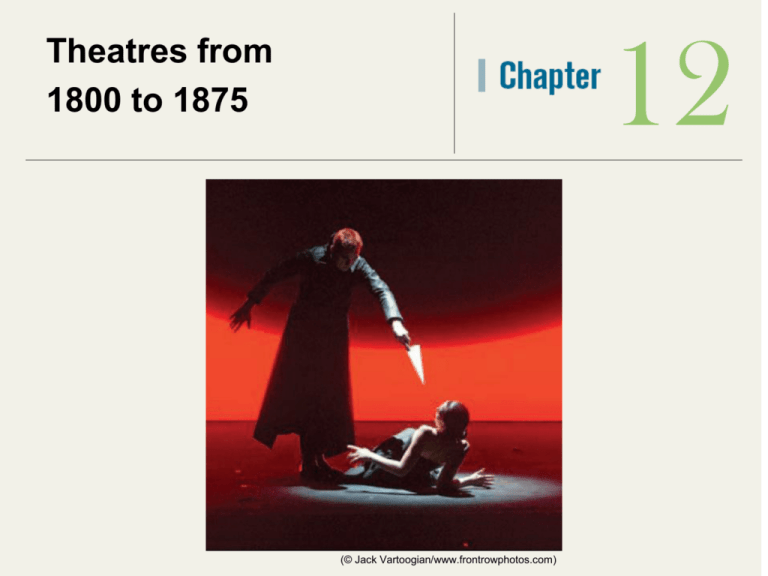
12
Theatres from
1800 to 1875
(© Jack Vartoogian/www.frontrowphotos.com)
1-2
Background:
The Nineteenth Century
• Importance of the industrial revolution
– Rise in the use of machinery
– Development of factories and the factory
system
• Darwin and Marx challenged long-held
beliefs in supremacy of God and a social
hierarchy established by God; they, with
Freud and others, would have a profound
effect on the western world
© 2012, The McGraw-Hill Companies, Inc. All Rights Reserved.
1-3
Theatre in
Nineteenth-Century Life
• Popular
Entertainments
– Minstrel shows
– Circuses
– Burlesque
(Library of Congress)
© 2012, The McGraw-Hill Companies, Inc. All Rights Reserved.
1-4
Theatre in
Nineteenth-Century Life (continued)
• Audiences
– Popularity of theatre, 1800–1875, not equaled
in modern times
– Movies and television are in a sense modern
counterparts—present similar kinds of
entertainment, attract mass audiences, have
popular stars
– But intense passion of nineteenth-century
audiences has rarely been found in other
entertainments
© 2012, The McGraw-Hill Companies, Inc. All Rights Reserved.
1-5
Theatre in
Nineteenth-Century Life (continued)
• Theatre Riots
– Reflected general
displeasure with
pricing and styles
– Most violent riots
occurred outside
the Astor Place
Theatre in New
York City
© 2012, The McGraw-Hill Companies, Inc. All Rights Reserved.
(Painting by C. M. Jenkes. The Metropolitan Museum of Art, The Edward
W. C. Arnold Collection of New York Prints, Maps, and Pictures, Bequest
of Edward W. C. Arnold, 1954 [54.90.222].)
1-6
Theatre in
Nineteenth-Century Life (continued)
• Theatre and Nationalism
– Anna Cora Mowatt
• Fashion: one of the very first
American social comedies,
advocating American sensibility
rather than slavish imitation of
foreign fashions
• Character types included a
Yankee, a French maid, an African
American servant, a French count,
and an American hero
© 2012, The McGraw-Hill Companies, Inc. All Rights Reserved.
(Billy Rose Theatre Collection, New York
Public Library at Lincoln Center, Astor,
Lenox, and Tilden Foundations)
1-7
Nineteenth-Century Drama
• Romanticism
– Romantics rejected
neoclassical rules—
rejected all artistic rules,
suggesting genius
creates its own rules
• Melodrama
– “Song drama” or
“music drama”
(© Paul Kolnik)
© 2012, The McGraw-Hill Companies, Inc. All Rights Reserved.
1-8
Nineteenth-Century Drama
(continued)
• The Well-Made Play
– Many popular melodramas of the nineteenth
century had a well-made-play structure
– One that showed excellent craftsmanship
– Term implied admiration for all the wellcrafted goods of the industrial revolution
© 2012, The McGraw-Hill Companies, Inc. All Rights Reserved.
1-9
Nineteenth-Century
Theatre Production
• Acting Styles
– Edmund Kean and
Charles Kean
– The Kembles
– William Charles
Macready
• Acting Theory:
Delsarte
(Billy Rose Theatre Collection, New York Public Library
for the Performing Arts, Astor, Lenox, and Tilden Foundations)
© 2012, The McGraw-Hill Companies, Inc. All Rights Reserved.
1-10
Nineteenth-Century
Theatre Production (continued)
• The Acting Profession
– Touring
– Ira Aldridge
– The Long Run and the
Decline of Repertory
Companies
– The Rise of the
International Star
– Sara Bernhardt and
Eleonora Duse
© 2012, The McGraw-Hill Companies, Inc. All Rights Reserved.
(© Musée Citadelle Vauban/Corbis Sygma)
Sarah Bernhardt, portrait by Georges Clairin.
1-11
Nineteenth-Century
Theatre Production (continued)
• Further Steps Toward
Directing
– Actor-Managers and
Playwright-Managers
– Madame Vestris: Lucia
Elizabetta Bartolozzi
– Laura Keene
– Two Early Directors
Laura Keene
(Billy Rose Theatre Collection, New
York Public Library at Lincoln Center,
Astor, Lenox, and Tilden Foundations)
Richard Wagner
• Richard Wagner
• Georg II, Duke of
Saxe-Meiningen
(© The Art Archive/Corbis)
© 2012, The McGraw-Hill Companies, Inc. All Rights Reserved.
1-12
Nineteenth-Century
Theatre Production (continued)
• Theatre Architecture
– Booth’s Theatre
– Edwin Booth
– Wagner’s
Festspielhaus
© 2012, The McGraw-Hill Companies, Inc. All Rights Reserved.
(© ArenaPal/Topham/The Image Works)
1-13
Nineteenth-Century
Theatre Production (continued)
• Scenery, Costuming, and Lighting
– Historical Accuracy
– The Box Set
• Consists of flats hinged together to represent a
room
• Often has practicable elements, such as doors and
windows that can be used during the course of a
presentation
– New Technology
© 2012, The McGraw-Hill Companies, Inc. All Rights Reserved.
1-14
(From Scientific American, April 5, 1884)
Nineteenth-Century
Theatre Production (continued)
© 2012, The McGraw-Hill Companies, Inc. All Rights Reserved.
1-15
Theatre in Russia Reflects
Nineteenth-Century Trends
• Under Catherine the Great, Russian
theatrical activity increased
– 1771, ordered the Bolshoi Theatre built in
Saint Petersburg; 1779, established the
Imperial Theatre School to train Russian
actors, dancers, and singers
– Alexander Griboyedov
– Alexander Pushkin
– Mikhail Lermontov
– Nikolai Gogol
© 2012, The McGraw-Hill Companies, Inc. All Rights Reserved.





